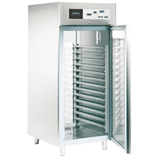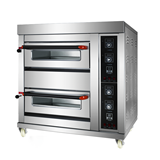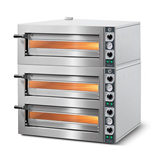Key takeaways
- Prover deck oven types: Choose between standalone provers, integrated prover-deck oven combos, or modular systems. Decks and capacities vary by baking load.
- Prices in Australia (2025):
- Standalone provers: $3,500–$8,000+
- Deck ovens: $6,000–$20,000+
- Integrated prover deck ovens: $12,000–$35,000+
- Operations: Deck ovens provide high-heat, even baking ideal for artisanal bread, while provers ensure optimal dough proofing temperature and humidity.
- Maintenance: Regular cleaning, seal inspections, and heating element testing are essential to maintain longevity and safety.
- Financing: Equipment loans, lease-to-own and rent-to-buy options available through Australian lenders. Low-doc options exist for established bakeries.
- Compliance: Must comply with Australian Food Safety Standards (FSANZ) and electrical safety regulations.
- Warranty & support: Most commercial ovens offer 1–3 years warranty. Look for brands with strong local aftersales support.
Introduction
Whether you're launching a new bakery, expanding production capacity, or upgrading from ageing equipment, choosing the right prover deck oven is essential to your operational success. These units combine a proofing chamber, where dough rests and rises, with a high-heat deck oven, allowing for continuous workflow and artisanal baking quality.
In this guide, we’ll walk you through everything you need to know about buying prover deck ovens in Australia. From pricing insights and types of ovens to maintenance tips, certification requirements and finance options, you'll gain the practical knowledge needed to make a confident and well-informed purchase.
Types of prover deck ovens available in Australia
Before diving into pricing, it's important to understand the different configurations available:
1. Standalone provers
- Used solely for dough proofing
- Often available in double-door, single-door, or roll-in rack styles
- Suitable for bakeries with separate baking ovens
2. Deck ovens (without prover)
- Multiple baking chambers (or "decks") for baking different products simultaneously
- Ideal for crusty breads, pizza bases, and pastries
- May be gas or electric
3. Integrated prover deck ovens
- Combine the prover (bottom) and deck oven (top) in one vertical unit
- Ideal for space-constrained bakeries
- Ensures a streamlined workflow from proving to baking
4. Modular baking systems
- Allow flexible configuration of prover and deck combinations
- Expandable as production scales
Prover deck oven prices in Australia (2025)
Indicative costs based on supplier quotes and bakery equipment distributors across Australia:
- Standalone provers:
- Small roll-in or upright: $3,500 – $5,500
- Large or double-door: $6,000 – $8,000+
- Deck ovens (electric/gas):
- 1–2 deck: $6,000 – $10,000
- 3–4 deck: $11,000 – $20,000+
- Integrated prover deck ovens:
- Entry-level combo units: $12,000 – $18,000
- Premium brands with digital controls: $20,000 – $35,000+
Pro tip: Imported ovens (especially from Europe or Asia) may offer lower upfront pricing but may have longer lead times or limited local support.
How prover deck ovens work
- Proving (proofing) chamber: Maintains a warm, humid environment (typically 30°C–38°C at 75–85% humidity) to allow dough fermentation before baking.
- Deck ovens: Feature flat stone or metal decks. Heat is distributed via electric elements or gas burners for even, controlled baking.
- Manual vs automatic controls: Basic models may use manual dials; advanced models offer programmable cycles, touchscreen controls and steam injection.
Installation and operation considerations
- Power requirements:
- Electric deck ovens: Typically 3-phase, 10kW–20kW draw
- Gas ovens require licensed installation and adequate ventilation
- Space planning:
- Allow clearance for loading trays, airflow, and cleaning access
- Consider unit height if stacking prover and oven
- Training: Staff must be trained on temperature controls, cycle timings, and safe loading/unloading techniques
Energy efficiency and running costs
Energy consumption is one of the most critical factors to consider when buying a prover deck oven in Australia, especially for high-throughput bakeries where ovens operate daily for long periods.
- Average electricity usage: Electric prover deck ovens typically consume between 8–12 kWh per deck per hour, depending on insulation, heating element quality, and bake settings.
- Insulation and seal quality: Poor insulation and degraded door seals can increase energy consumption by up to 20%, as heat escapes and the system must work harder to maintain temperature.
- Electric vs gas: While gas ovens often have lower energy costs per hour, they may require more maintenance and upfront installation expenses. Over five years, a mid-sized electric deck oven may cost $10,000–$14,000 in power usage, while a similar gas oven may total $8,000–$12,000 in fuel, but include an additional $2,000–$4,000 in servicing.
- Heat-up time efficiency: Models with faster heat-up times reduce idle energy wastage. Investing in ovens with programmable timers and standby features can reduce energy use by up to 15%.
- Calculating running costs: Multiply the oven’s hourly kWh usage by your current electricity rate (typically $0.25–$0.40 per kWh in commercial settings) and average daily usage hours. For gas models, use your gas tariff in MJ/h and convert accordingly.
Space and installation planning
Prover deck ovens are heavy-duty appliances that require careful planning to ensure safe installation, functional workspace integration, and long-term serviceability.
- Common dimensions:
- 1-deck ovens: 1200–1400mm wide, 900–1100mm deep, 600–900mm high
- 2-deck ovens: similar footprint, but 1200–1500mm high
- 3-deck ovens: up to 1800mm high, sometimes modular
- Weight: A single-deck oven may weigh 250–400kg, while 3-deck units often exceed 700kg. Reinforced flooring or commercial-grade caster supports are typically required.
- Ventilation requirements: Adequate airflow must be provided, especially for gas ovens. Many commercial kitchens will require ducting to comply with building codes and prevent heat accumulation.
- Installation costs: Expect to pay between $800 and $2,500 depending on delivery logistics, size, and whether specialist trades (e.g. gasfitters, electricians) are needed.
- Compliance certifications: Before operation, ensure your unit:
- Meets Australian/New Zealand electrical and gas safety standards (AS/NZS 60335, AS/NZS 5601)
- Is installed by a licensed technician with sign-off from a qualified certifier if applicable
- Is included on your maintenance schedule for ventilation and safety checks
Maintenance and servicing
Regular upkeep extends the lifespan and safety of your prover deck oven:
- Daily: Wipe down surfaces, clean trays, remove crumbs
- Weekly: Descale water/steam systems, inspect seals and gaskets
- Monthly: Test heating consistency, check thermostats, calibrate sensors
- Annually: Schedule professional servicing, especially for gas units
Replacement parts such as door gaskets, thermostat probes, steam injectors, and heating elements are generally available from local distributors or directly from the brand.
Warranties and support
- Standard warranty periods: 12–36 months for most brands
- Check what’s covered: Parts only, or parts and labour?
- Local representation: Prioritise brands with service technicians in your state
- Extended warranties: Some suppliers offer up to 5-year plans for added peace of mind
Financing options in Australia
Many Australian bakeries rely on equipment financing to manage cash flow. Consider:
- Chattel mortgage: Retain ownership with fixed monthly repayments
- Lease-to-own: Make monthly payments with ownership at end of term
- Rental finance: Ideal for short-term or seasonal operations
- Low-doc options: Available for established businesses with good trading history
Typical loan terms: 2–5 years, interest rates from 7.5%–13% p.a. depending on credit profile and asset age
Compliance and certification in Australia
Buying a prover deck oven means ensuring full compliance with:
- AS/NZS electrical safety standards – Units must meet local electrical codes
- Gas installation codes – Licensed technician installation required for gas ovens
- Food Safety Australia and New Zealand (FSANZ) – All food-contact surfaces must be easy to clean and sanitise
- WorkSafe equipment handling – Safe loading and ergonomic design considerations
Hidden costs to watch out for
- Delivery and installation: Can add $500 – $2,500+ depending on site complexity
- Customs and duties: If importing direct, expect to pay 5–10% in import fees
- Ongoing electricity or gas costs: Estimate $1.50–$5.00 per hour of use, depending on oven size and power draw
- Downtime costs: Inadequate maintenance can result in production losses
Inventory and usage forecasting tips
- Batch planning: Calculate maximum capacity per deck (e.g., 8–12 loaves per deck per cycle)
- Demand forecasting: Align baking load to peak demand windows (e.g., weekend markets or cafe orders)
- Spare parts on hand: Keep spare elements and gaskets to avoid downtime
- Scaling up: Choose a modular system that allows additional decks to be added as demand grows
FAQs: Prover deck ovens in Australia
What’s the difference between a deck oven and a convection oven?
Deck ovens use radiant heat and are ideal for crusty breads and artisan products. Convection ovens circulate hot air and are better suited for pastries, pies, and cookies.
Can I use a prover deck oven in a home bakery?
Most models are commercial-grade and require 3-phase power or gas connections. Compact models may be suitable for microbakeries with the right infrastructure.
Are second-hand units worth it?
They can offer good value, but always:
- Ask for a service history
- Inspect heating elements and gaskets
- Check for compliance with current standards
How long do they last?
Well-maintained units can last 10–15 years. Steam systems and thermostats typically need replacing around year 5–7.
Final thoughts
Investing in a quality prover deck oven is a strategic decision that affects the consistency, quality, and capacity of your bakery’s production, and ultimately, your bottom line. With Australia's competitive foodservice landscape, choosing the right oven can help you streamline operations, meet growing demand, and maintain high product standards day after day.
Whether you're launching a new bakery or upgrading ageing equipment, keep in mind:
- The right fit matters more than the biggest unit, consider your daily output, available space, and energy infrastructure.
- Upfront cost vs long-term value, lower-cost units may cost more in energy, repairs, or downtime over time.
- Certifications and installation, ensure your oven is compliant and correctly installed to avoid costly legal or operational issues.
- Financing options, from lease-to-own to chattel mortgages, explore financing structures that preserve your working capital.
A reliable prover deck oven is more than a piece of machinery, it's the heart of your baking operation. Taking the time to assess your needs, compare features, and understand true lifetime costs will lead to a more profitable and sustainable investment.







